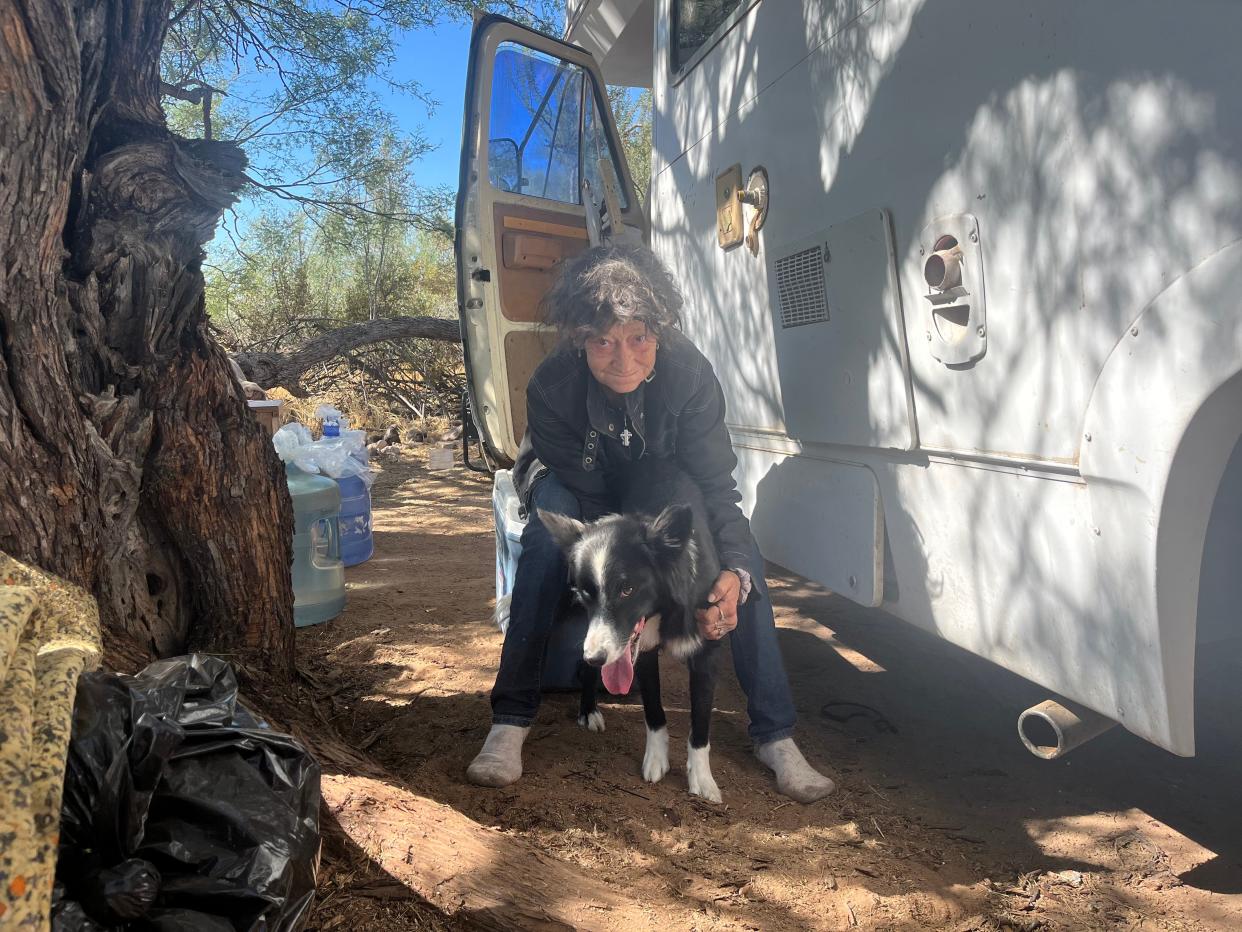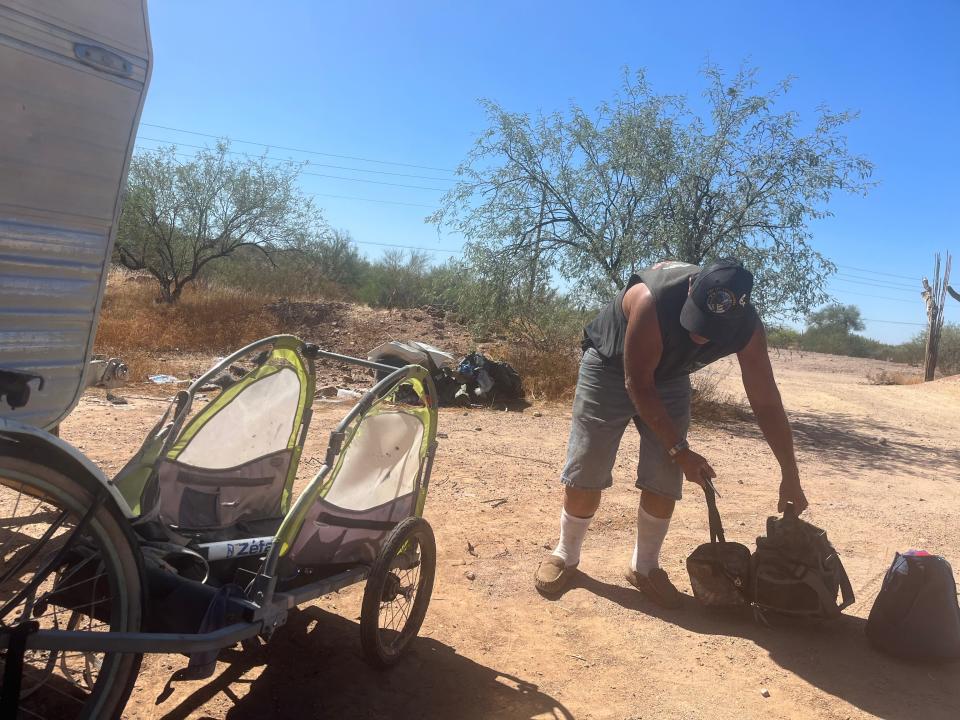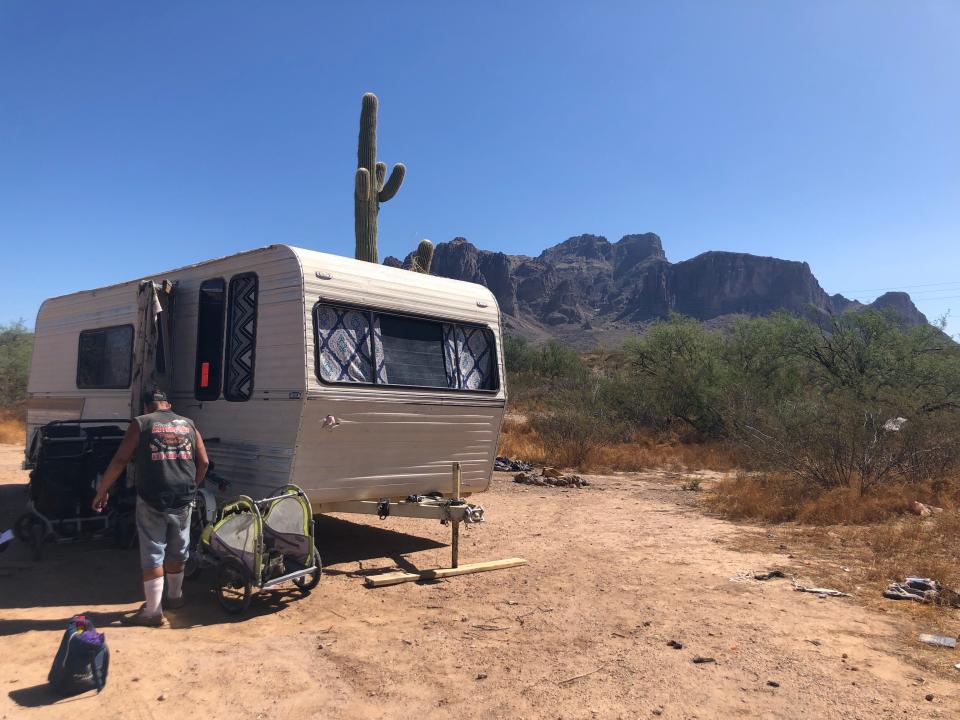A camping area in Pinal County will face new rules. What about the people living there?

When Bill Shelly and Rose Sherwood moved to Arizona, living out of their RV was supposed to be temporary.
They hoped to eventually find an affordable home. But four years later, the pair are still camping out of their vehicle in the desert outside Goldfield Ghost Town, an 1800s-themed tourist attraction up the road from Apache Junction.
It’s an area that has long attracted people who need a place to stay. Rose’s son, Billy Sherwood, lives just a few steps away in a large orange tent featuring bongos and some cooking gear.
“It could be worse, it could,” Rose said. “But we want a home.”
A house remains out of reach, and the family may soon need to move somewhere new. The land’s owner, the Bureau of Land Management, recently approved a measure that will convert it into a 1,100-acre recreation area.
The pivot comes as Apache Junction is continuing to grow, and metro Phoenix is quickly urbanizing. It's fueling increasing demand for nearby park spaces.
The new recreation area will offer trails for hiking, mountain biking and horseback riding, BLM spokesperson Chris Wonderly said. It will include amenities such as equestrian staging areas, hitching posts, picnic tables, toilets and signage.
The federal agency aims to make the land usable for more people. It also seeks to quell concerns about trash, illegal camping and fire risk.
But some worry it could also push vulnerable people further into rural desert areas, putting them at increased risk of crime, dehydration and other dangers.
Familiar issues present different challenges
It's a dilemma similar to those playing out in urban areas, as government officials weigh public safety and possible neighborhood nuisances against displacing homeless people and moving them farther away from services.
Unlike their urban counterparts, America's growing population of rural homeless people is often less visible than those in cities. They also have access to far fewer resources, increasing the potential danger of moving further into the wilderness.

Regulations generally allow campers to stay on federal land for up to 14 days, but many in the area have been overstaying their welcome.
It's unclear exactly how many people might be impacted by the shift in camping regulations. Wonderly couldn’t provide an estimate of how many people live in the area. He said rangers “do notice more activity in the cooler months.”
Local officials said it's nearly impossible to get a sense of the scale of homelessness in rural areas. Pinal County’s most recent point-in-time count shows just over 200 homeless people countywide. Experts believe that is a significant undercount.
Heather Patel of the Pinal County Coalition to End Homelessness said even now, people without homes who live on BLM land are far enough into the desert that emergency vehicles and outreach workers often struggle to reach them. If they are forced to move further away from resources, Patel expects to see an increase in deaths.
Limited housing: Peoria seniors lose services as independent living facility becomes apartments
“It’s just not safe at all,” she said.
Wonderly said BLM will need to temporarily shut down the area for construction before the new recreation area opens. The agency will give campers 30 days to vacate, which he said will be prompted by publishing a memo in the Federal Register once BLM determines when construction will begin.
Shelly and Rose Sherwood said the heads-up may not help much. It’s hard to think of housing alternatives, they said.
“There’s nowhere else to go,” Shelly said.
BLM's recreation area aims to ‘reduce user conflict’ and protect land
The proposed recreational area has seen more and more campers in recent years, BLM officials wrote in an environmental assessment. Combined with the regular flouting of the 14-day camping limit, officials say it's leading to problems.
Rangers in the past years have removed thousands of pounds of rubbish from the land and disposed of about 15 abandoned vehicles, Wonderly said. In addition to garbage, the increased activity is leading to heightened wildfire risk, drug activity, noise and complaints from residents and land recreationists.
Even Shelly and Rose Sherwood, who advocate for BLM to leave the area as it is, noted trash is an accumulating issue.
“Only problem is the slobs,” Shelly said, adding his family bags their garbage and takes it to the dump.

BLM officials wrote in their environmental assessment they need to act to “reduce user conflicts” and “contribute toward a more harmonious relationship” with the public. They believe a recreation area will ensure “the long-term protection of public land” and “encourage improved visitor behavior and ethics” while expanding recreation opportunities.
Others like Patel are skeptical that the potential benefits of establishing a recreation area outweigh the possible harms. She said litter is likely wherever people are living. If homeless people are pushed into the wilderness, trash might be less visible, but will also be more difficult to pack out and clean up.
“It will end up hurting them and it will end up hurting our state,” she said.
What happens to the people already living in the area?
Shelly has chronic obstructive pulmonary disease, an illness that makes it difficult for him to breathe. Three times per day, he uses a machine called a nebulizer to inhale tiny droplets of medication into his lungs.
He described the disease as akin to breathing through a tiny straw. While the nebulizer helps, he said, he’s “screwed” without it.
“It’s like being in a bear hug that gets tighter every day,” he said.
Shelly's condition makes his family hesitant to move farther away from town. The trip to get treatment is already a hassle, he said, and moving away would make daily life even more difficult. He’s also unsure if an ambulance could reach his current site, let alone somewhere more remote.
“The farther you go out, the harder it is,” Shelly said.
Other safety concerns exist. Billy Sherwood said he likes to keep to himself because he is wary of nearby strangers. Theft and other crimes aren't uncommon, he said.
“It’s dog-eat-dog out here,” he said.
Wonderly said rangers try to take an educational approach to enforcing the rules. The majority of law enforcement interactions in the area do not end in citations, he said.
He declined to release citation data to The Arizona Republic, citing an internal policy against doing so. BLM has yet to respond to a public records request for copies of citations issued in recent years.
Wonderly said rangers also refer homeless people to social services when they encounter them. But there’s a lack of resources to help homeless people in Pinal County, Patel said, which makes it harder to connect long-term campers with services that can help them.
Some homeless people are reluctant to accept assistance. Trinity Frey runs an Apache Junction soup kitchen called the Genesis Project and has served hundreds of people experiencing homelessness in the area. She said many people camping on BLM land have found ways to adapt to the desert, and are not necessarily seeking help.
She believes people living on the land have enough know-how to navigate the change safely. Still, she hopes the land can continue to be used by a variety of populations as it goes through the upcoming transition.
“They have policies in place for a reason,” Frey said. “And that is to encourage everyone to enjoy the land in a lawful and healthy way.”
Sasha Hupka covers county government and regional issues for The Arizona Republic. Do you have a tip? Reach her at sasha.hupka@arizonarepublic.com. Follow her on X, formerly Twitter: @SashaHupka. Follow her on Instagram or Threads: @sashahupkasnaps.
Helen Rummel covers housing insecurity and homelessness for The Arizona Republic. Reach her at hrummel@gannett.com.
Coverage of housing insecurity on azcentral.com and in The Arizona Republic is supported by a grant from the Arizona Community Foundation.
This article originally appeared on Arizona Republic: New rules on BLM land in Pinal County may force homeless campers out

